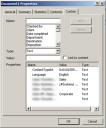Last week, I attended the Microsoft event in Louvain-La-Neuve where they launched their new Unified Communications products. As always, it was a very impressive show with lots of presentations, information, partner boots… Unified Communication will be a great tool to increase productivity and offer new ways of communication to the information workers.
I can’t wait to start using it, but as a trainer, I am also wondering how we will teach people how to use it? Using Office Communicator, is this something that you can learn in a classroom environment? Just imagine 10 students calling each other… Will you learn it using e-learning? Seems rather static and unreal to me. Do you have any suggestions?
One thing I realised is that it will be necessary for the users to understand the full picture of the infrastructure: where is my mailbox, what is happening when I start a voice chat, what happens when someone calls me, when I divert a call…
Another thing that I am always curious about is the different presentation skills and the presentation styles of the presenters. Presentation Zen has a an interesting blog post about the presentation styles of Microsoft’s Number One compared to Apple’s Steve Jobs.
I had the luck of seeing Bill Gates in action on the Vista launch last year, and I can agree with some of the remarks of Garr Reynolds; and as an Apple fan, I never miss a keynote of Steve. But to select a “winner” would be disrespectful for both: they are both passionate about what they do in their own way, and I experienced it again in Louvain-La-Neuve last week.


